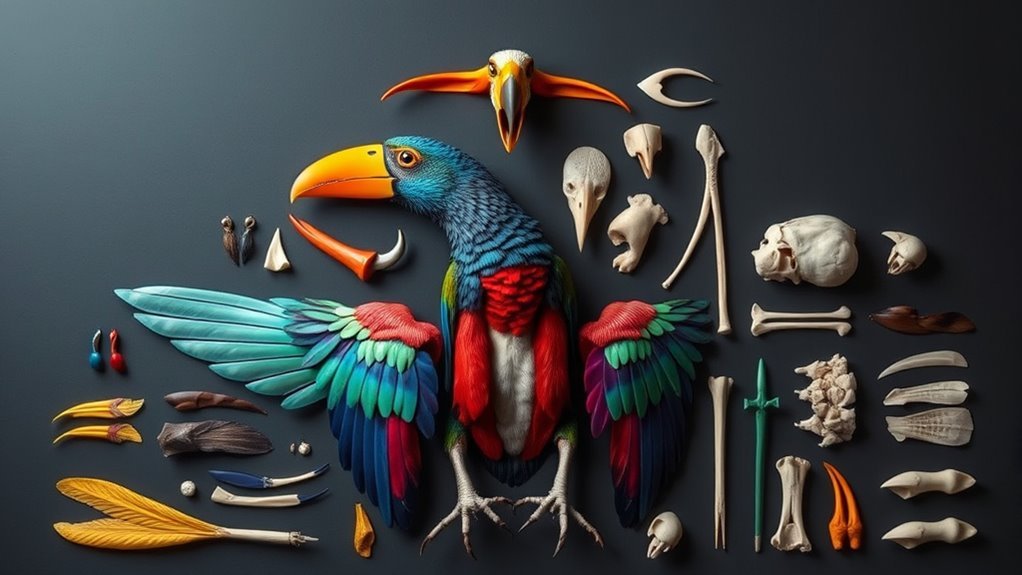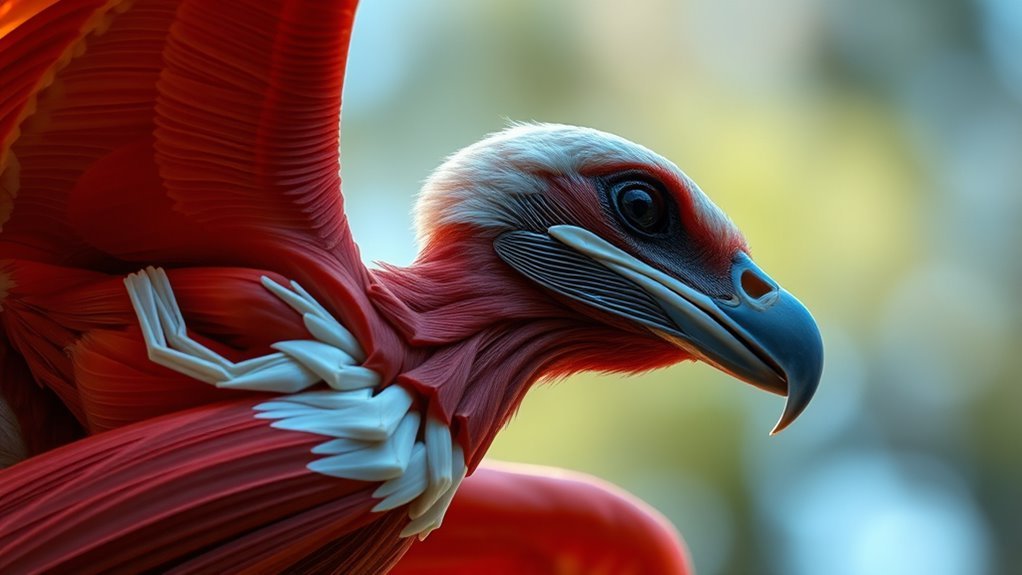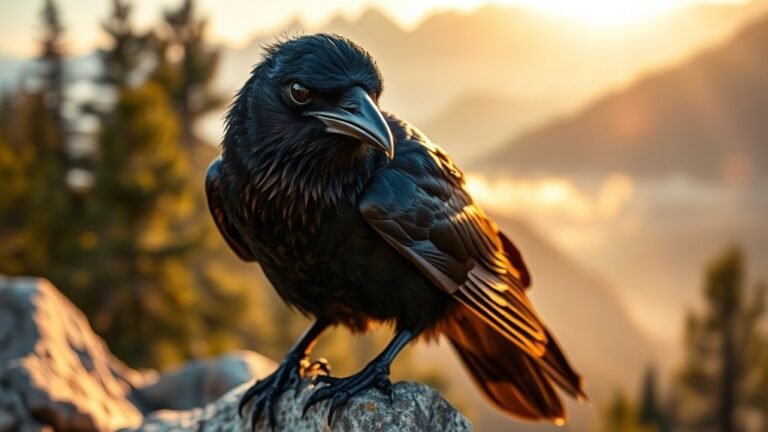A Comprehensive Glossary of Bird Anatomy Terms
Bird anatomy plays a crucial role in their adaptations and ecological functions. Their skeletal systems support flight, while specialized respiratory systems provide the oxygen they need for high energy. Each anatomical feature contributes to a bird's ability to survive and adapt in different environments. By learning these terms, you can gain insights into the fascinating evolution of birds.
Key Takeaways
- Feathers: Essential for flight and insulation; types include primary, secondary, and down for different functions.
- Beak Variations: Different shapes are adapted to specific diets, like sharp hooks for meat or long, thin structures for nectar.
- Skeletal Adaptations: Hollow bones reduce weight, while fused bones enhance wing strength for efficient flight.
- Muscle Groups: Specialized muscles, like the pectoralis major, drive wing movements necessary for flight.
- Respiratory Features: Continuous airflow through air sacs aids in efficient oxygen extraction during high-energy activities like flying.
Overview of Bird Anatomy

Bird anatomy helps them fly efficiently. Each body part has a specific role. Feathers are a key feature of birds. They've different types, including primary, secondary, and down feathers.
Primary and secondary feathers help with flight, while down feathers provide warmth.
Bird beaks also vary between species, which shows their eating habits. For example, hawks have sharp, hooked beaks for tearing meat. Hummingbirds have long, thin beaks that help them drink nectar from flowers.
Knowing these features can increase your appreciation for birds. You become more connected to the diverse bird species in nature.
Enjoy learning about these amazing creatures.
Skeletal System
The skeletal system of birds is adapted for flight. It provides both support and lightness. Birds have hollow bones that reduce weight while maintaining strength. These bones also have air sacs, which further decrease weight.
Some bones, like the sternum and clavicles, are fused together. This fusion creates a strong framework that helps birds move their wings powerfully for flight.
Additionally, bird skeletons protect vital organs and help produce red blood cells in bone marrow. Learning about the bird skeletal system shows how they fly effectively and highlights their amazing anatomy.
Muscular System

Birds have a lightweight skeleton and a specialized muscular system that helps them fly.
This system includes two main types of muscles: flight muscles and stabilizing muscles. The flight muscles are crucial for flapping the wings, while the stabilizing muscles maintain balance during flight.
The pectoralis major is the primary flight muscle and is responsible for the downstroke of the wings. The supracoracoideus muscle aids in the upstroke. These muscles connect closely to the bird's skeleton, allowing for efficient movement and precise control.
Digestive System
Understanding the digestive system in birds is important for learning how they turn food into energy for flying and daily tasks. The process starts with the beak, which varies based on the bird's diet and helps them gather food efficiently.
After the bird eats, the food goes to the crop, where it's stored and softened, making digestion easier. Next, the gizzard uses its muscle structure to grind the food further for better nutrient absorption.
Keeping the intestines healthy is essential for good nutrient absorption and overall health. A balanced diet plays a key role in all these processes.
Respiratory System

Birds have a unique respiratory system that distinguishes them from other animals. This system features air sacs that are essential for efficient gas exchange.
When a bird inhales, air enters both the lungs and the air sacs. This process ensures a continuous flow of fresh oxygen, even while exhaling. As a result, birds can extract oxygen more effectively than mammals.
This ability supports their high energy needs, especially during flight. The swift movement of air through these sacs improves oxygen delivery to their body tissues.
Understanding how this respiratory system works highlights how birds adapt to their environment and showcases the remarkable aspects of bird anatomy.
Circulatory System
The circulatory system of birds is efficient. It has two loops that help them stay active. This system ensures oxygen-rich blood goes to tissues and helps remove carbon dioxide.
Birds have a four-chambered heart, which separates oxygenated and deoxygenated blood effectively. Blood vessels run throughout their bodies. Arteries carry blood away from the heart, while veins bring it back.
Capillaries are tiny blood vessels that allow the exchange of nutrients and gases at the cellular level. This supports the high energy needs of flying. Understanding this system shows how well birds adapt to different environments.
Reproductive System
Birds have specialized reproductive systems that help them succeed in many environments. Understanding how these systems work can enhance your appreciation of their behaviors.
Here are the key components:
- Oviposition: Birds lay eggs in carefully chosen locations to promote egg development.
- Mating behavior: Birds perform courtship rituals to form pair bonds and attract mates.
- Egg structure: The egg has a shell and membranes that provide protection and nourishment to the embryo.
- Incubation: Parents regulate temperature and humidity during incubation to ensure successful development.
These elements show how birds adapt their reproduction strategies to thrive in the wild.
Frequently Asked Questions
How Do Birds Communicate Using Their Anatomy?
Birds communicate through sounds and movements. They make chirps and calls to send specific messages to each other. Additionally, they use body language, such as wing flaps and head tilts, to show feelings and assert their position in social situations. This combination of vocalizations and physical gestures helps them express their thoughts and emotions clearly.
What Role Does Feather Structure Play in Flight?
Feather structure is crucial for flight. Different types of feathers have specific aerodynamic features. These features influence the balance between lift and drag, helping birds move efficiently in the air. Understanding this relationship allows us to appreciate how birds fly with grace and precision.
How Do Birds Maintain Body Temperature?
Birds maintain their body temperature using various methods. They shiver to generate heat and they pant to cool down. Feathers serve as insulation, trapping heat and keeping their bodies warm. This helps them adjust to different temperatures in their surroundings efficiently. By using these simple yet effective methods, birds can thrive in a range of environments.
What Are Common Anomalies in Bird Anatomy?
When studying common anomalies in bird anatomy, you will encounter several key issues. Beak deformities can limit birds' ability to eat or groom themselves. Wing malformations can affect their ability to fly or escape predators. Feather abnormalities may impact insulation and flight. Skeletal issues can result in mobility problems. Recognizing these problems is important for understanding bird health and survival.
How Does Anatomy Vary Among Different Bird Species?
Anatomy varies significantly among bird species. Birds have different beak shapes that help them eat specific types of food. For example, a hawk has a sharp beak for tearing meat, while a hummingbird has a long, slender beak for sipping nectar.
Wings also differ among species. Swift birds, like swallows, have long, pointed wings for fast flying. In contrast, birds that fly slowly, like albatrosses, have long, wide wings for gliding long distances.
These anatomical differences show how birds adapt to their environments and food sources. By studying these variations, we gain insight into the diverse roles birds play in nature.

Hello, I’m Emily Price, the founder of Birds Affection. As a passionate bird enthusiast and spiritual seeker, I’ve always been fascinated by the symbolic meanings and mystical connections between birds and our lives. On this website, I share my knowledge and insights on the spiritual significance of various bird species, exploring their roles as messengers, guides, and teachers. Through my writing, I aim to inspire and educate others on the profound wisdom and beauty that birds bring to our world. Join me on this journey as we delve into the enchanting realm of bird symbolism and discover the hidden meanings behind these magnificent creatures.







